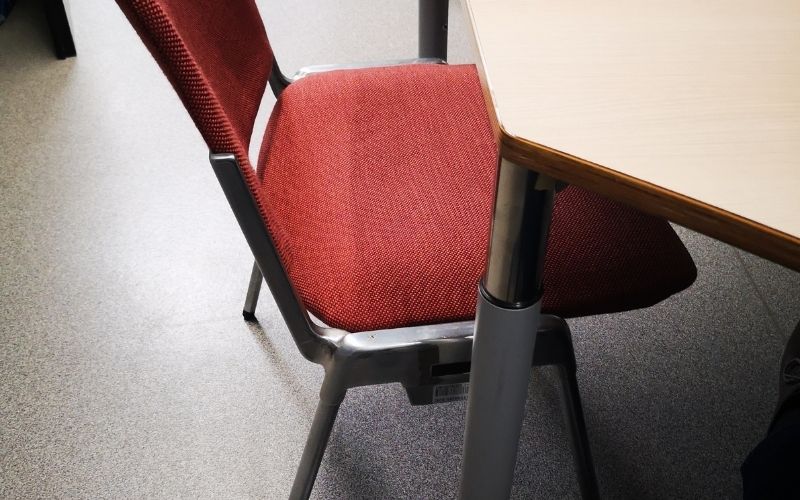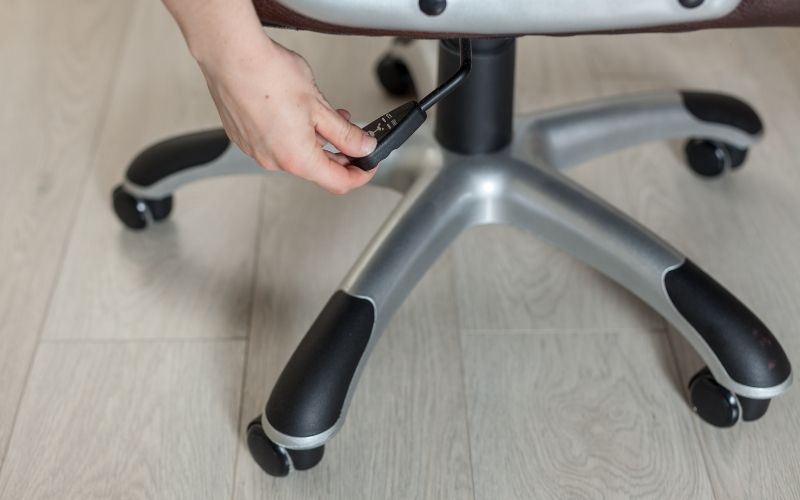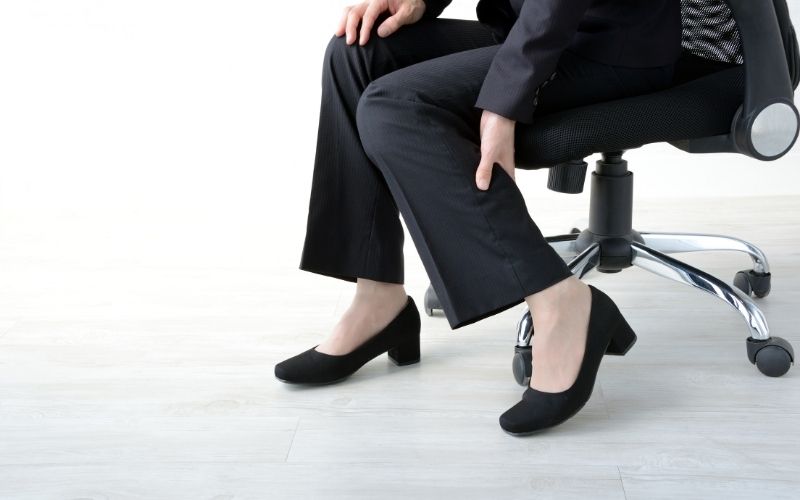If you have a desk job and spend more than eight hours a day working while seated, you know how important it is to have a good quality office chair.
In many cases, prolonged sitting can have short and long-term effects on your body and overall health, some more serious than others. Sitting for long hours can hurt your back, neck, and shoulders and even cause obesity, heart disease, anxiety, and depression.
Imagine how much worse it can be if you’re using the wrong chair.
If you’re feeling some muscle pain in your lower extremity, you might be wondering, ‘Can a bad office chair cause leg pain?’
This article will answer the questions you may have about the effects of sitting on a bad office chair. We will give you some valuable tips on how to relieve and prevent leg pain.
We will also talk about how you can spot a bad office chair to make wise decisions when buying a new one. So read on because you will not want to miss this!
A bad office chair is a common culprit of leg pain. It does not provide enough body support, promoting a poor sitting posture, disrupting blood circulation, and improper pressure distribution. Improper blood flow often leads to muscle swelling.
Table of Contents
Can sitting on a hard chair cause leg pain?

Yes, sitting on a hard chair can cause leg pain, especially after prolonged periods. Not only does your bottom hurt due to the stiff surface, but you also tend to shift the pressure from your feet to your knees and thighs, causing your legs to go weak because you aren’t using them enough.
Your leg muscles are built to hold you when you move. When you don’t engage them enough, it can lead to muscle atrophy or wasting, a condition caused by a lack of physical activity.
Why does a bad office chair cause leg pain?

There are various reasons why a bad office chair can cause leg pain. One of them might be because it is not allowing you to sit correctly.
According to research, the correct sitting posture maintains contact between your back and the chair’s backrest, supports your lumbar spine, keeps your arms parallel to your desk, positions your hips slightly above your knees, leaves a gap between the seat and the back of your knees, and keeps your feet flat on the floor.
If, for instance, your office chair has a high seat and is not adjustable, your feet may hang above the floor. And you may find yourself crossing your legs so that one foot can touch the ground.
Sitting with crossed legs or with an ankle over your knee can constrict blood circulation and possibly damage your veins in the long run. In some severe cases, people develop a condition known as deep vein thrombosis, which develops blood clots in the lower part of their legs.
Sitting on an office chair that is too high destabilizes your body, causing tiredness. The poor sitting posture puts pressure on your thighs, reducing the backflow of blood and causing swelling in the legs and ankles.
Sitting on a chair with a seat too low also disrupts blood circulation.
How do I know if my office chair is bad?
If you’re feeling discomfort in your neck, shoulders, back, and legs, experiencing loss of muscle function, as well as fatigue and lack of concentration, chances are you are sitting on the wrong chair. However, you can also tell if an office chair is bad by observing and taking notes of its lack of features.
Below are some of the signs and symptoms of a bad office chair:
- The seat height is not adjustable.

As mentioned earlier, sitting on an office chair that doesn’t have height adjustments can cause strain in your leg muscles.
Switch to an office chair with an adjustable seat height so you can sit with both your feet firm on the ground.
- It does not offer decent back support.
A bad office chair has little to no lumbar support. A good one has a backrest that fits the natural S curve of your spine, encouraging proper sitting posture.
- It does not have good ergonomic features.

A good office chair offers a lot of ergonomic features that benefit your health and productivity. These include adjustable lumbar support, armrests, headrests, height adjustments, 360-degree swivel, etc.
If your office chair is missing most of these features, we strongly recommend you replace it.
- It has a poor build quality.
An office chair that has poor build quality is usually unstable and may even be unsafe.
To make sure you sit comfortably and stay productive while you work, you need a sturdy and stable chair.
- The casters do not move smoothly.
Another sign that you have a bad office chair is if the casters do not move smoothly. It compromises mobility and requires you to put pressure on your legs as you try to move the wheels, not to mention that it can damage your flooring.
- It does not have proper seat padding.

Prolonged sitting on a chair that is hard and stiff will never be comfortable.
Office chairs with over-padded seats such as executive chairs provide the most comfort, while cheap, low-quality ones usually have hard mesh seats that are nowhere near flexible.
- It has a low weight capacity.
If your office chair’s weight capacity is lower than your body weight, then it is bad for you. It will directly affect your chair’s mobility.
Make sure your chair can carry your weight so that you can move easily while seated.
- It has a short warranty period.
A warranty of one year or less is indeed a red flag. It is a sign that your office chair is not durable and is easily replaceable.
Good quality office chairs have warranties that last at least five years. Some expensive ones even have guarantees that extend up to 15 years.
What should I do to stop leg pain caused by a bad office chair?
Leg pain from sitting for hours on a bad office chair is common but should be addressed before it worsens.
To stop leg pain caused by a bad office chair, you can try applying ice on swollen areas for 10 to 15 minutes for quick relief and repeat it about two to three times a day. Prevention, however, is still the best solution.
Here are a few tips on how to prevent leg pain from prolonged sitting:
- Don’t forget to take breaks.

When you’ve got a lot to do, it can be tempting to finish all your work in one sitting and just take a rest once you’re done. However, doing so will not be good for your overall health.
Give yourself well-deserved breaks. Stand up, walk, exercise, or at least stretch in your seat.
When you sit too long, you are essentially not using the largest muscles in your body. Your legs become weak from inactivity, and they start to ache.
- Adjust your seat height.

Adjusting your seat height helps you properly distribute pressure in your body, reducing the risks of numbness and swelling of the leg muscles and allowing proper blood circulation. It also reduces straining of your neck and shoulders.
- Get a footrest.

If you are short and can’t get the perfect seat height with your office chair, you should consider buying a footrest. It will help you maintain a proper posture by keeping your feet flat on a surface, sit comfortably, and prevent leg pain.
- Upgrade to an ergonomic office chair.

If budget is not a problem, we recommend you upgrade to an ergonomic office chair.
Most good-quality ergonomic office chairs offer many adjustable features, providing you with a good amount of support and comfort. They are also durable and will last you quite a while.
- See a doctor.

If your leg pain becomes more frequent, intense, and unbearable, do not self-medicate. Do not take painkillers.
The best thing to do would be to see a doctor.
Conclusion
To summarize, sitting for long hours in an office chair that is either too high or too low for you can lead to leg pains.
So if you want to minimize or prevent the discomfort, you should set your chair at a height that will allow you to sit comfortably and properly. Or better yet, invest in an ergonomic chair with adjustable features that can adapt to your height, body shape, etc., and can suit your personal preferences.
Also, if you begin to experience or see signs of leg pain from sitting on your office chair for a long time, do not dismiss it. Follow the tips we laid out above and adopt good habits to help you fix and prevent leg pain.
No matter how busy you are, pause for a while, and move those muscles.

My name is Vance, and I am the owner of To Ergonomics. Our mission is to improve your workflow by helping you create a supportive and welcoming environment. We hope that you’ll find what you’re looking for while you’re here.

